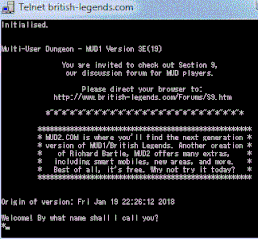LambdaMOO is an online community of the variety called a MOO. It is the oldest MOO today.
A multi-user dungeon, also known as a multi-user dimension or multi-user domain, is a multiplayer real-time virtual world, usually text-based or storyboarded. MUDs combine elements of role-playing games, hack and slash, player versus player, interactive fiction, and online chat. Players can read or view descriptions of rooms, objects, other players, and non-player characters, and perform actions in the virtual world that are typically also described. Players typically interact with each other and the world by typing commands that resemble a natural language, as well as using a character typically called an avatar.

Digital Equipment Corporation (DEC)'s PDP-10, later marketed as the DECsystem-10, is a mainframe computer family manufactured beginning in 1966 and discontinued in 1983. 1970s models and beyond were marketed under the DECsystem-10 name, especially as the TOPS-10 operating system became widely used.
AberMUD was the first popular open source MUD. It was named after the town Aberystwyth, where it was written. The first version was written in B by Alan Cox, Richard Acott, Jim Finnis, and Leon Thrane based at University of Wales, Aberystwyth for an old Honeywell mainframe and opened in 1987.
DikuMUD is a multiplayer text-based role-playing game, which is a type of multi-user domain (MUD). It was written in 1990 and 1991 by Sebastian Hammer, Tom Madsen, Katja Nyboe, Michael Seifert, and Hans Henrik Stærfeldt at DIKU —the department of computer science at the University of Copenhagen in Copenhagen, Denmark.
TOPS-10 System is a discontinued operating system from Digital Equipment Corporation (DEC) for the PDP-10 mainframe computer family. Launched in 1967, TOPS-10 evolved from the earlier "Monitor" software for the PDP-6 and PDP-10 computers; this was renamed to TOPS-10 in 1970.
LPMud, abbreviated LP, is a family of multi-user dungeon (MUD) server software. Its first instance, the original LPMud game driver, was developed in 1989 by Lars Pensjö. LPMud was innovative in its separation of the MUD infrastructure into a virtual machine and a development framework written in the programming language LPC.
A persistent world or persistent state world (PSW) is a virtual world which, by the definition by Richard Bartle, "continues to exist and develop internally even when there are no people interacting with it". The first virtual worlds were text-based and often called MUDs, but the term is frequently used in relation to massively multiplayer online role-playing games (MMORPGs) and pervasive games. Examples of persistent worlds that exist in video games include Battle Dawn, EVE Online, and Realms of Trinity.

Richard Allan Bartle FBCS FRSA is a British writer, professor and game researcher in the massively multiplayer online game industry. He co-created MUD1 in 1978, and is the author of the 2003 book Designing Virtual Worlds.

MUD2 is the successor of MUD1, Richard Bartle's pioneering Multi-User Dungeon. Rather than a sequel, it is the result of over 20 years of continuous development, and is still largely based on the game's original code.

Kelton Flinn is an American computer game designer who is a major pioneer in online games. He is a co-founder of the seminal online game company Kesmai, which they began in 1982. His best known title is the first graphical multi-player online game offered by a major service, Air Warrior (1987).
A text game or text-based game is an electronic game that uses a text-based user interface, that is, the user interface employs a set of encodable characters, such as ASCII, instead of bitmap or vector graphics.
Island of Kesmai was an early commercial online game in the multi-user dungeon (MUD) genre, innovative in its use of roguelike pseudo-graphics. It is considered a major forerunner of modern massively multiplayer online role-playing games (MMORPGs).
The history of massively multiplayer online games spans over thirty years and hundreds of massively multiplayer online games (MMOG) titles. The origin and influence on MMO games stems from MUDs, Dungeons & Dragons (D&D) and earlier social games.
TinyMUCK or, more broadly, a MUCK, is a type of user-extendable online text-based role-playing game, designed for role playing and social interaction. Backronyms like "Multi-User Chat/Created/Computer/Character/Carnal Kingdom" and "Multi-User Construction Kit" are sometimes cited, but are not the actual origin of the term; "muck" is simply a play on the term MUD.
The School of Computer Science and Electronic Engineering at the University of Essex is an academic department that focuses on educating and researching into Computer Science and Electronic Engineering specific matters. It was formed by the merger of two departments, notable for being amongst the first in England in their fields, the Department of Electronic Systems Engineering(1966) and the Department of Computer Science (1966).

Avalon: The Legend Lives is a text-based online multi-player role-playing game world that was first released on 28 October 1989 at the gaming convention Adventure 89. It has maintained a near-continuous on-line presence with consistent and intact persona files and player history since the late 1980s. Until regular outages began occurring in 2023, it was the longest continuously running online role-playing game in history.

Dr Nigel Roberts FIoD FBCS FRSA is a British computer scientist.







